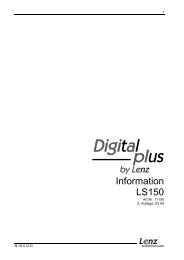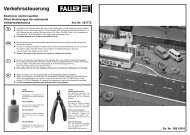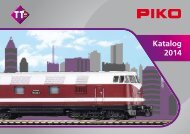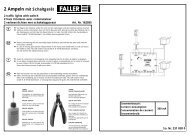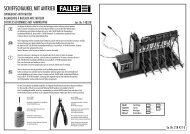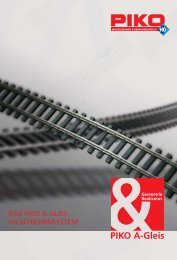INSTRUCTION MANUAL
INSTRUCTION MANUAL
INSTRUCTION MANUAL
Create successful ePaper yourself
Turn your PDF publications into a flip-book with our unique Google optimized e-Paper software.
Decoder MX620 - MX622, MX630 - MX632 Sound Decoder MX640 - MX648 Page 21<br />
3.9 The ZIMO “signal controlled speed influence” (HLU)<br />
ZIMO digital systems offer a second level of communication for transmitting data to vehicles in specific<br />
track sections. The most common application for this is the “signal controlled speed influence” for stopping<br />
trains and applying speed limits in 5 stages, with data sent to the track sections as needed in the form of<br />
HLU cut-outs prepared by MX9 track section modules or its successors. This feature only operates within<br />
ZIMO systems.<br />
* The speed limits “U”(Ultra low) and “L” (Low speed) as well as the intermediate limits of the “signal controlled<br />
speed influence” can be defined with configuration variables #51 to #55 as well as the acceleration<br />
and deceleration values (momentum) with CV #49 and #50.<br />
Please note that the signal controlled acceleration and deceleration times in CV #49 and #50 are always<br />
added to the times and curves programmed to CV #3, 4, 121, 122 etc. Signal controlled accelerations and<br />
decelerations compared to cab controlled momentum can therefore only progress either at the same rate (if<br />
CV #49 and #50 is not used) or slower (if CV #49 and/or #50 contain a value of >0), but never faster.<br />
It is of utmost importance for a flawlessly working train control system using the signal controlled speed influence<br />
that the stop and related brake section lengths are arranged properly and consistently everywhere<br />
on the layout. Please consult the MX9 instruction manual.<br />
The deceleration (often CV #52 for “U” limit) and brake (CV #4 and #50) characteristics should be set so<br />
that all locos come to a complete stop within about 2/3 of the stop section, which in HO is typically about 15<br />
to 20 cm before the end of a stop section. Setting the loco up to stop precisely within the last centimeter of<br />
a stop section is not recommended.<br />
CV Designation Range Default Description<br />
#49<br />
#50<br />
#51<br />
#52<br />
#53<br />
#54<br />
#55<br />
#59<br />
Signal controlled<br />
(HLU)<br />
acceleration<br />
Signal controlled<br />
(HLU)<br />
deceleration<br />
Signal controlled<br />
(HLU) speed limits<br />
#52 for “U”,<br />
#54 for “L”,<br />
#51, 53, 55<br />
for intermediate steps<br />
Signal controlled<br />
(HLU)<br />
delay<br />
0 - 255 0<br />
0 - 255 0<br />
0 - 255<br />
20<br />
40 (U)<br />
70<br />
110 (L)<br />
180<br />
0 - 255 5<br />
ZIMO signal controlled speed influence (HLU) with<br />
ZIMO MX9 track section module or future module<br />
or<br />
when using the “asymmetrical DCC signal” stopping<br />
method (Lenz ABC).<br />
The content of this CV, multiplied by 0.4, equals the<br />
time in seconds for the acceleration event from standstill<br />
to full speed.<br />
ZIMO signal controlled speed influence (HLU) with<br />
ZIMO MX9 track section module or future module<br />
or<br />
when using the “asymmetrical DCC signal” stopping<br />
method (Lenz ABC).<br />
The content of this CV, multiplied by 0.4, equals the<br />
time in seconds for the deceleration event (braking)<br />
from full speed to standstill.<br />
ZIMO signal controlled speed influence (HLU) with<br />
ZIMO MX9 track section module or future module:<br />
Each of the 5 speed limits (CV’s #51 – 55) that can be<br />
applied with the ZIMO “signal controlled speed influence”<br />
can be defined with an internal speed step.<br />
ZIMO signal controlled speed influence (HLU) with<br />
ZIMO MX9 track section module or future module<br />
or<br />
when using the “asymmetrical DCC signal” stopping<br />
CV Designation Range Default Description<br />
method (Lenz ABC):<br />
Time in tenth of a second until the locomotive starts to<br />
accelerate after receiving a higher signal controlled<br />
speed limit command.<br />
3.10 “Asymmetrical DCC-Signal” stops (Lenz ABC)<br />
The “asymmetrical DCC signal” is an alternative method for stopping trains at a “red” signal. A simple<br />
circuit made up of 4 or 5 commercially available diodes is all that is required.<br />
3 – 5 silizium diodes in series and<br />
one Schottky diode parallel in the<br />
opposite direction is the usual arrangement.<br />
The different voltage drops across the<br />
diodes results in an asymmetry of<br />
about 1 to 2V. The direction in which<br />
the diodes are mounted determines<br />
the polarity of the asymmetry and with<br />
it the driving direction a signal stop is<br />
initiated.<br />
Stop section<br />
Main track<br />
The asymmetrical DCC signal stop<br />
mode needs to be activated in the<br />
decoder with CV #27. Normally Bit 0<br />
is set, that is CV #27 = 1, which results<br />
in the same directional control as the “Gold” decoder from Lenz.<br />
The asymmetrical threshold (0.4V by default) can be modified with CV #134 if necessary (i.e. if the<br />
DCC signal of a given command station is already offset to begin with). At the time of this writing, the<br />
“asymmetrical DCC signal” has not been standardized and many DCC systems pay no attention to<br />
this feature.<br />
CV Designation Range Default Description<br />
#27<br />
Track power from<br />
command station<br />
Switc h to<br />
cancel stop<br />
when signal<br />
turns “green”<br />
red<br />
Silicium diodes,<br />
i.e. 1N5400x<br />
(3 A - Types)<br />
Direction<br />
dependent stops<br />
with asymmetrical DCC<br />
signal<br />
(Lenz “ABC” method<br />
Note:3 diodes in series is<br />
the minimum required to<br />
stop ZIMO decoders. 4 or<br />
more diodes are sometimes<br />
needed for other decoder<br />
brands. Because the diodes<br />
cause an undesired voltage<br />
drop, use the minimum<br />
number of diodes possible.<br />
Travel direction<br />
0, 1, 2, 3 0<br />
Bit 0 = 1: Stops are initiated if voltage in right rail<br />
is higher than left rail (in direction of<br />
travel). This setting, CV #27 = 1, IS THE<br />
COMMON APPLICTION for this<br />
feature (provided the decoder is wired<br />
to the rail correctly).<br />
Bit 1 = 1: Stops are initiated if voltage in left rail<br />
is higher than right rail (in direction of<br />
travel).<br />
Stopping is directional if only one of the two bits is set<br />
(not both). Traveling in the opposite direction will have<br />
no effect. Use the other bit In case the train stops in the<br />
wrong direction!




